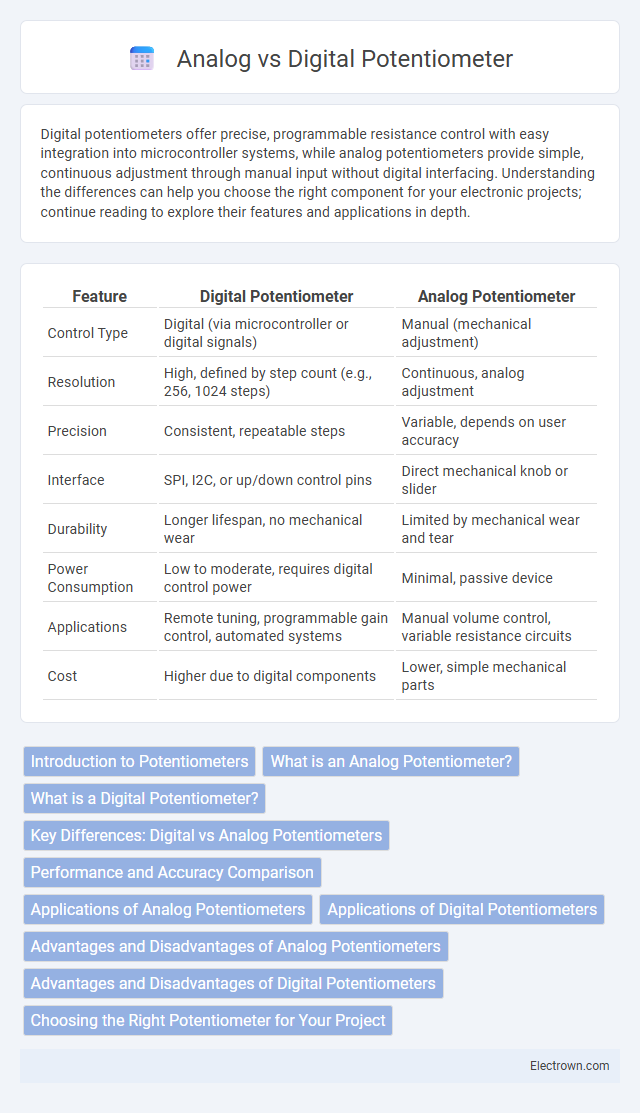Digital potentiometers offer precise, programmable resistance control with easy integration into microcontroller systems, while analog potentiometers provide simple, continuous adjustment through manual input without digital interfacing. Understanding the differences can help you choose the right component for your electronic projects; continue reading to explore their features and applications in depth.
Table of Comparison
| Feature | Digital Potentiometer | Analog Potentiometer |
|---|---|---|
| Control Type | Digital (via microcontroller or digital signals) | Manual (mechanical adjustment) |
| Resolution | High, defined by step count (e.g., 256, 1024 steps) | Continuous, analog adjustment |
| Precision | Consistent, repeatable steps | Variable, depends on user accuracy |
| Interface | SPI, I2C, or up/down control pins | Direct mechanical knob or slider |
| Durability | Longer lifespan, no mechanical wear | Limited by mechanical wear and tear |
| Power Consumption | Low to moderate, requires digital control power | Minimal, passive device |
| Applications | Remote tuning, programmable gain control, automated systems | Manual volume control, variable resistance circuits |
| Cost | Higher due to digital components | Lower, simple mechanical parts |
Introduction to Potentiometers
Potentiometers serve as variable resistors that control voltage and current in electronic circuits, available in digital and analog formats. Analog potentiometers adjust resistance via a physical wiper sliding along a resistive element, providing continuous and smooth control. Digital potentiometers use electronic signals to set resistance in discrete steps, offering precision and remote configurability ideal for modern applications.
What is an Analog Potentiometer?
An analog potentiometer is a variable resistor that provides continuous adjustment of voltage or current by physically sliding a wiper over a resistive element, allowing precise control in circuits. It operates through mechanical movement, making it intuitive for fine-tuning applications such as audio volume controls or sensor calibration. Your projects benefit from its simplicity and reliability in producing smooth, real-time analog signal variations.
What is a Digital Potentiometer?
A digital potentiometer is an electronic component that mimics the function of a traditional analog potentiometer by providing adjustable resistance through digital signals. It consists of a resistor array and electronic switches controlled by a digital interface such as SPI or I2C, allowing precise and repeatable resistance adjustments without mechanical movement. Digital potentiometers are commonly used in applications requiring remote tuning, programmable gain control, and automated calibration in modern electronic circuits.
Key Differences: Digital vs Analog Potentiometers
Digital potentiometers use electronic switches and resistive elements to adjust resistance in discrete steps, offering precise and programmable control ideal for microcontroller integration. Analog potentiometers provide continuous resistance variation through a mechanical wiper sliding over a resistive track, supporting smooth, real-time manual adjustments. Key differences include resolution, with digital potentiometers offering fixed steps versus the infinite variability of analog types, and durability, as digital units have no mechanical wear compared to analog potentiometers.
Performance and Accuracy Comparison
Digital potentiometers offer higher precision and repeatability due to their fixed step increments and digital control, resulting in improved accuracy over analog potentiometers, which rely on mechanical wiper movement that can introduce noise and wear. Analog potentiometers provide smooth, continuous resistance adjustment but are prone to drift, mechanical degradation, and environmental influences, reducing long-term performance consistency. Overall, digital potentiometers excel in applications requiring stable, high-resolution tuning, while analog variants remain suitable for simpler, cost-sensitive designs.
Applications of Analog Potentiometers
Analog potentiometers are widely used in applications requiring precise manual adjustment of voltage or signal levels, such as volume controls in audio equipment and tuning circuits in radios. Their ability to provide continuous variable resistance makes them ideal for sensor calibration and user interface controls in industrial machinery. Additionally, analog potentiometers are favored in simple electrical circuits and prototype testing due to their straightforward operation and real-time tactile feedback.
Applications of Digital Potentiometers
Digital potentiometers are extensively used in precision control applications such as audio volume adjustment, sensor calibration, and variable gain amplifiers where exact resistance tuning is essential. Their ability to interface directly with microcontrollers enables automated and repeatable adjustments in systems like programmable filters and motor controllers. Your designs benefit from digital potentiometers' reliability in harsh environments and their convenience for remote or software-driven calibration tasks.
Advantages and Disadvantages of Analog Potentiometers
Analog potentiometers offer smooth, continuous adjustment of resistance, making them ideal for applications requiring fine-tuning and precise control. They are simple to use, cost-effective, and provide reliable feedback through mechanical movement, but their physical wear over time can lead to reduced accuracy and potential failure. Your choice to use an analog potentiometer should consider their vulnerability to noise and limited integration with digital systems compared to digital potentiometers.
Advantages and Disadvantages of Digital Potentiometers
Digital potentiometers offer precise, programmable resistance adjustments, enabling seamless integration with microcontrollers for accurate control in electronic circuits. They provide benefits like enhanced repeatability, non-mechanical operation, and the ability to store and recall resistance values, making them ideal for automation and remote applications. However, they may suffer from limited resolution compared to analog counterparts and often require complex interfacing circuitry, which could affect cost and design simplicity.
Choosing the Right Potentiometer for Your Project
Selecting the right potentiometer depends on your project's precision and control needs. Digital potentiometers provide accurate, programmable resistance adjustments ideal for automated systems, while analog potentiometers offer simple, manual control with tactile feedback. Consider your application's complexity, cost constraints, and required durability to determine whether a digital or analog potentiometer best suits your design.
digital vs analog potentiometer Infographic

 electrown.com
electrown.com